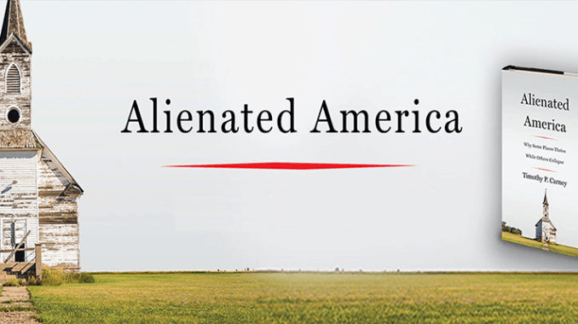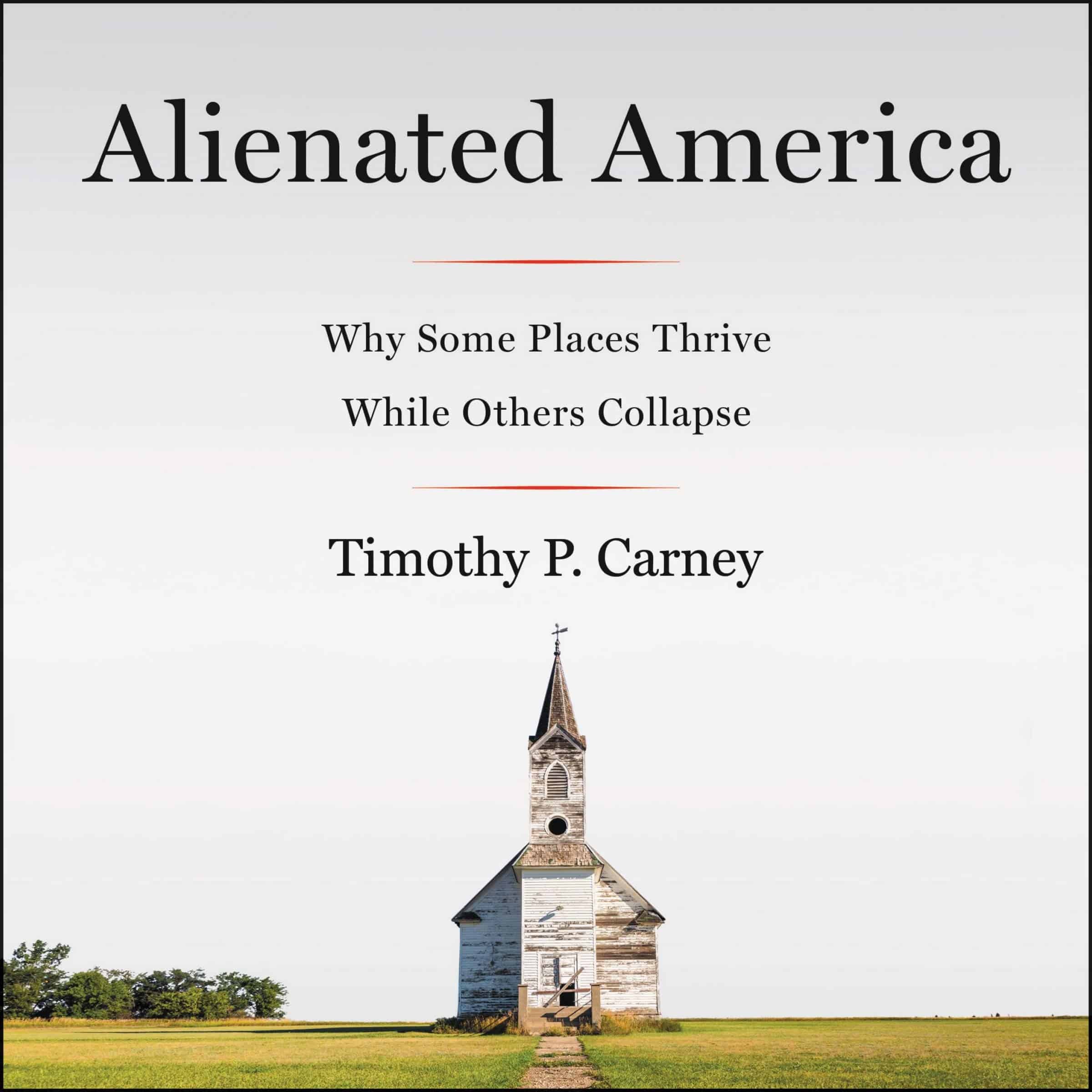REVIEW: ‘Alienated America’ by Timothy P. Carney

 Tim Carney’s new book on social alienation and U.S. politics, Alienated America: Why Some Places Thrive While Others Collapse, raises the bar for Trump-era political analysis. Building on recent research on economics and civic life from various sources, Carney presents an incisive analysis of The Donald’s 2016 campaign that redefines who supported the 45th president and why. The book’s policy prescriptions, while not likely to show up in most 2020 candidates’ campaign platforms, flow directly from his assessment of what’s really wrong with America in the 21st century.
Tim Carney’s new book on social alienation and U.S. politics, Alienated America: Why Some Places Thrive While Others Collapse, raises the bar for Trump-era political analysis. Building on recent research on economics and civic life from various sources, Carney presents an incisive analysis of The Donald’s 2016 campaign that redefines who supported the 45th president and why. The book’s policy prescriptions, while not likely to show up in most 2020 candidates’ campaign platforms, flow directly from his assessment of what’s really wrong with America in the 21st century.
We’ve seen many books in the past few years that have attempted to dissect the Trump campaign and its unexpected success. Carney, however, focuses not on the man himself, or his campaign staff, but on the people who were his early and strongest supporters—those who agreed most strongly with candidate Trump’s dramatic declaration that “the American dream is dead.” He finds that these people live in places where social engagement is low, churches are shuttering, and trust among neighbors is dwindling—including, but not limited to, many of the “post-industrial” Rust Belt towns profiled by so many other political writers. These core supporters are not necessarily the people who are suffering opioid overdoses and attempting suicide at record rates, but, as Carney writes, they are those people’s neighbors.
Carney’s depiction of Trump super-fans as neighbors of the suffering is an important aspect of his redirection of the 2016 narrative. A great deal of left-leaning commentary about the election has been devoted to debunking the notion of Trump supporters as being afflicted by “economic anxiety,” and actually being motivated by racism, xenophobia, and other bigoted fixations. Liberal critics point out that those actually in poverty were more likely to have voted for Hillary Clinton. But the key difference is not people who voted for Trump over Hillary, but Republicans who, early on, supported Trump over more conventional GOP choices like Ted Cruz and Marco Rubio. Many of those people reside in more-affluent than average households, but also overwhelmingly live in places defined by declining demographic conditions.
Location is key. Carney argues that we need to understand the current social pathologies around us—including an alarming recent decline in U.S. life expectancy—as impacting not just disaffected individuals sprinkled evenly throughout the country, but as being rooted in specific communities that have seen the good things in life decline in recent years.
What has caused this community-specific decline in neighborliness, educational achievement, and public health outcomes? Carney identifies many of the usual suspects that both right- and left-leaning commentators have profiled in the past. For the conservative crowd, there’s the welfare state, still highly centralized, despite Bill Clinton-era reforms. These programs crowd out local initiatives, undermine self-reliance, and displace the neighborly help once provided by neighbors and fellow parishioners. Liberal critics will likely identify more with the critique of big corporations, like Walmart and Target, which have driven many small town shops out of business, eliminating informal “third places”—locations outside of home and work—where people used to gather for friendly interaction.
These big-picture trends have left Americans with fewer connections to each other. In a time when working-class Americans (men especially) find it more difficult to find and keep both jobs and spouses, there is less energy and motivation for joining the clubs, committees, and teams that are at the heart of a healthy community. And with more centrally administered government social benefits, Americans are able to scrape by (if only just barely in many places) without relying on anyone they actually know in their own community for help. Not relying on one’s neighbors, while face-saving in the short term, ultimately causes individuals to drift even further apart from the people they see every day.
To find out where these problems are having the biggest impact, Carney relies on some fascinating research and field work. “Alienated America” is at its best when it uses electoral and demographic data to overturn lazy narratives about social class and ideology. Not all small towns and rural communities are suffering the same alienating malaise, of course, and comparing small-but-flourish locales like Oostburg, Wisconsin, with flailing places like western Pennsylvania’s Mon Valley produces some fascinating insights.
Americans living in low-income communities generally have worse outcomes across a range of measures, whether it involves being employed, filing for bankruptcy, being a victim of crime, or suffering from a serious illness. This is not surprising, but the popular conventional wisdom often comes with an ostensible silver lining. The rich may have nice houses and fancy cars, but they lack the simple community and loving bonds that their poorer cousins enjoy—family, church, and their own humble neighborliness.
Carney calls this the “Lena Dunham fallacy,” after the TV producer, writer, and activist whose name has become shorthand among many conservatives for big city bohemian lifestyles and limousine liberal politics. But this old dichotomy of rich-but-empty vs. poor-but-virtuous turns out not to reflect society. The homespun values of education, marriage, hard work, and civic engagement are actually more likely to be seen among the middle and upper classes than in America’s low-income households. The million-dollar homes of the nation’s exclusive suburbs are much more likely, on any given evening, to be hosting a community fundraiser than a swingers’ party.
As marriage and church attendance decline, the statistics show, community fabric and positive family outcomes decline. Poor people are not only more likely to be afflicted by these trends in the first place, they have fewer options and resources for replacing those institutions in their own community. Not only are middle-class people more likely to be in intact marriages and families, they are more likely to be able to move or send their children to a private school if their neighborhoods exhibit decline, or to be able to seek out new institutions for support.
Which leads to one of Carney’s most counterintuitive conclusions. Middle- and upper-class Americans have not been corrupted by the progressive, free-love legacy of the 1960s, but they have been coopted by its non-judgmentalism. The people who now constitute the economic and professional elite—most of whom are highly educated and left-leaning—are either unable or unwilling to share the good news of the good life with their poorer neighbors. The most successful Americans live according to what most people would consider old-fashioned values, but refuse to preach what they practice. Social research has shown that not all life choices are equally likely to lead to long-term success, but a strong cultural disinclination toward saying so out loud has wreaked havoc on at least two generations of Americans.
So what about solutions? Fixing problems that are the result of decades-long economic and social trends can be a frustrating undertaking. Despite his emphasis on marriage and intact families, Carney does not suggest, as some conservatives have, a National Campaign for Fatherhood or a return to the short-lived “New Victorianism” of the early 1990s. He does recommend “small solutions” that would have a big long-term impact, in particular removing government policies that have had perverse effects on community formation.
In his final chapter, he states that, “the first step in regrowing the grass will be removing the paving stones.” That means less federal encroachment on state-level action and fewer policies hostile to religious institutions. Education policy, for example, should be structured and directed as locally as possible, less by state school boards than by local districts and parents. Labor unions can be reformed to provide social safety net services rather than just lobby for Democratic politicians. He also makes the fascinating but likely unpopular suggestion that eliminating the mortgage interest deduction will help build compact communities rather than diffuse, spread-out suburbs.
Carney, throughout, puts a strong emphasis on religious congregations as the most important—and most accessible—civil society institutions in America. His suggestions for cultivating the good life, individually, and as a community, revolve around strong churches, temples, and mosques. This will no doubt leave many secular readers cold, but the national demographic data suggest a very strong correlation between vibrant faith communities and positive sociological outcomes. That doesn’t mean that atheists have to become Lutherans, but that they should at least not let their atheism stand in the way of other Americans building stronger communities by embracing their faith traditions.